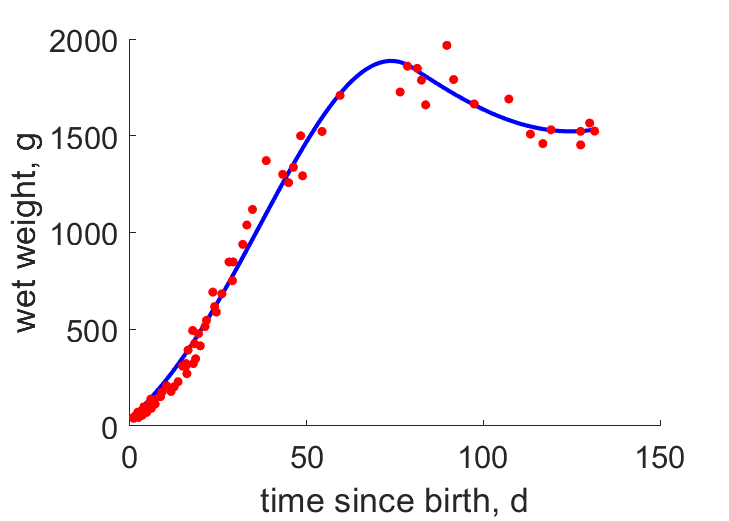Predictions & Data for this entry
| Model: std | climate: MA | migrate: | phylum: |
| COMPLETE = 2.5 | ecozone: MC | food: biCvf | class: |
| MRE = 0.021 | habitat: 0iMc | gender: Dg | order: |
| SMSE = 0.002 | embryo: Tnsfm | reprod: O | family: |
Zero-variate data
| Data | Observed | Predicted | (RE) | Unit | Description | Reference |
|---|---|---|---|---|---|---|
| ab | 43 | 43.56 | (0.01295) | d | age at birth | AnAge |
| tx | 131 | 131 | (0.0003239) | d | time since birth at fledging | Dorw1962 |
| tp | 393 | 384.6 | (0.02142) | d | time since birth at puberty | guess |
| tR | 1461 | 1461 | ( 0) | d | time since birth at 1st brood | AnAge |
| am | 9308 | 9303 | (0.0004358) | d | life span | AnAge |
| Wwb | 42 | 41.47 | (0.01273) | g | wet weight at birth | Dorw1962 |
| Wwi | 2000 | 2022 | (0.01075) | g | ultimate wet weight | Dorw1962 |
| Ri | 0.005479 | 0.005434 | (0.008238) | #/d | maximum reprod rate | AnAge |
Uni- and bivariate data
| Data | Figure | Independent variable | Dependent variable | (RE) | Reference |
|---|---|---|---|---|---|
| tW |  | time since birth | wet weight | (0.07229) | Dorw1962 |
Pseudo-data at Tref = 20°C
| Data | Generalised animal | Sula dactylatra | Unit | Description |
|---|---|---|---|---|
| v | 0.02 | 0.01973 | cm/d | energy conductance |
| p_M | 18 | 427 | J/d.cm^3 | vol-spec som maint |
| k_J | 0.002 | 0.01769 | 1/d | maturity maint rate coefficient |
| k | 0.3 | 0.3033 | - | maintenance ratio |
| kap | 0.8 | 0.9093 | - | allocation fraction to soma |
| kap_G | 0.8 | 0.8004 | - | growth efficiency |
| kap_R | 0.95 | 0.95 | - | reproduction efficiency |
Discussion
- Feeding is reduced towards end of nestling period
- Body temerature is guessed
- Long tp cannot be captured by std model
- mod_1: v is reduced
- mod_2: Pseudo-data point k is used, rather than k_J; Data set tp and parameter t_R are added, the latter replacing clutch interval t_N. Postnatal T is based on PrinPres1991, see get_T_Aves. See further the revision page, theme puberty
Bibliography